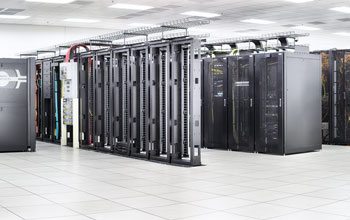All Images
News Release 13-056
NSF-Supported Blue Waters, One of the World's Most Powerful Computers, Is Open for Research
Blue Waters has been configured to solve the most challenging compute-, memory-, and data-intensive problems in science and engineering
This material is available primarily for archival purposes. Telephone numbers or other contact information may be out of date; please see current contact information at media contacts.

Blue Waters has been configured to solve the most challenging compute-, memory- and data-intensive problems in science and engineering. It has tens of thousands of chips (CPUs & GPUs), more than a petabyte of memory, tens of petabytes of disk storage, and hundreds of petabytes of archival storage.
Credit: NCSA/University of Illinois
Thom Dunning of NCSA describes Blue Waters, an NSF-funded supercomputer, now fully deployed.
Credit: NSF
NCSA's Thom Dunning describes some projects on Blue Waters and how it meets researchers' needs.
Credit: NSF
NCSA Director Thom Dunning describes an early discovery in AIDS research that Blue Waters enabled.
Credit: NSF
U.S. competitiveness includes advanced computational abilities. Thom Dunning rates Blue Waters.
Credit: NSF
The future of S&E research is brighter with Blue Waters as a resource for researchers, says Dunning.
Credit: NSF

NSF Acting Director Cora Marrett celebrates the dedication of the Blue Waters supercomputer with Farnam Jahanian, NSF Assistant Director for Computer & Information Science & Engineering Directorate (left), and Congressman Dan Lipinkski (D-IL 3rd District) (right), March 28, 2013.
Credit: NSF
